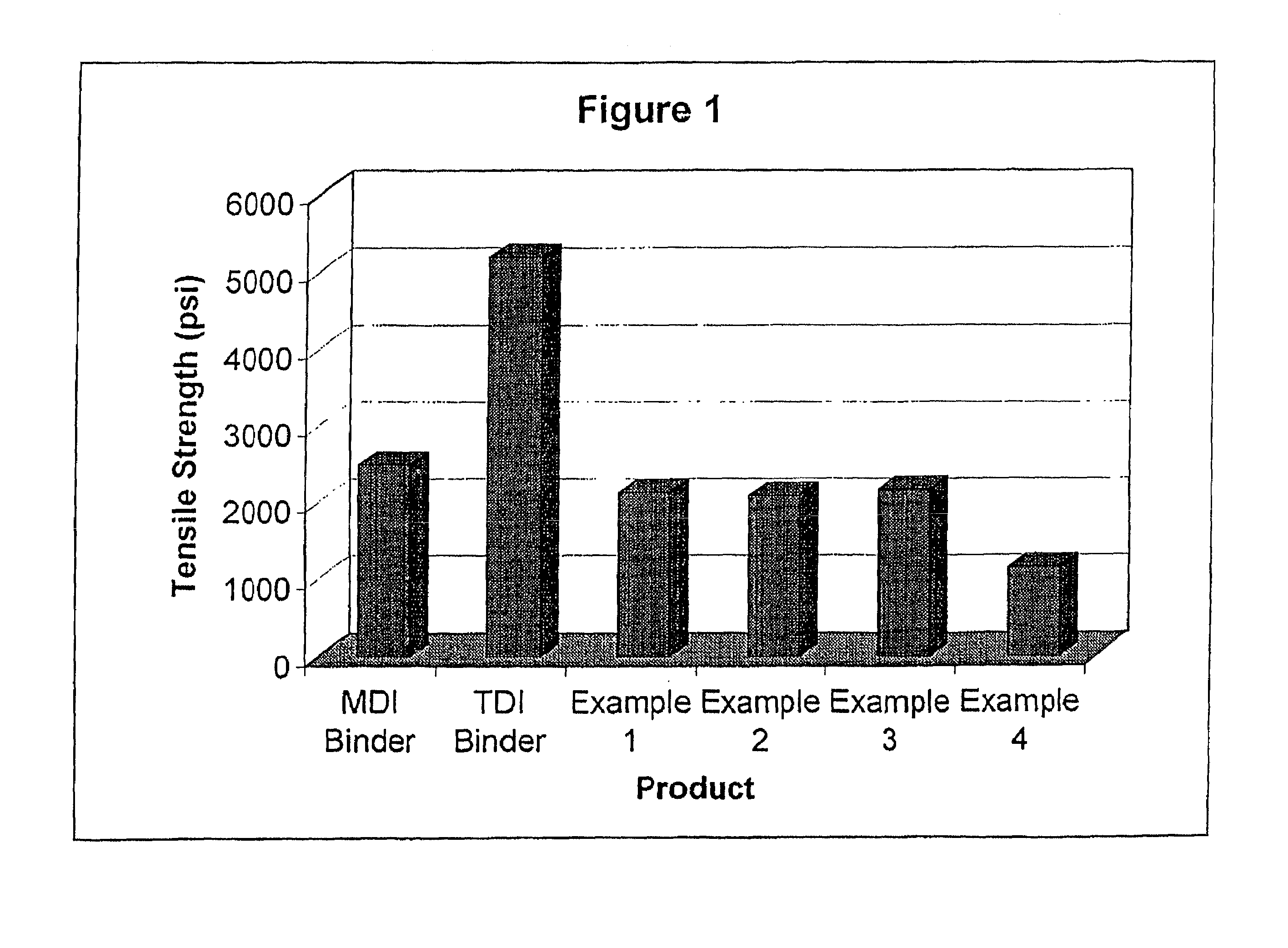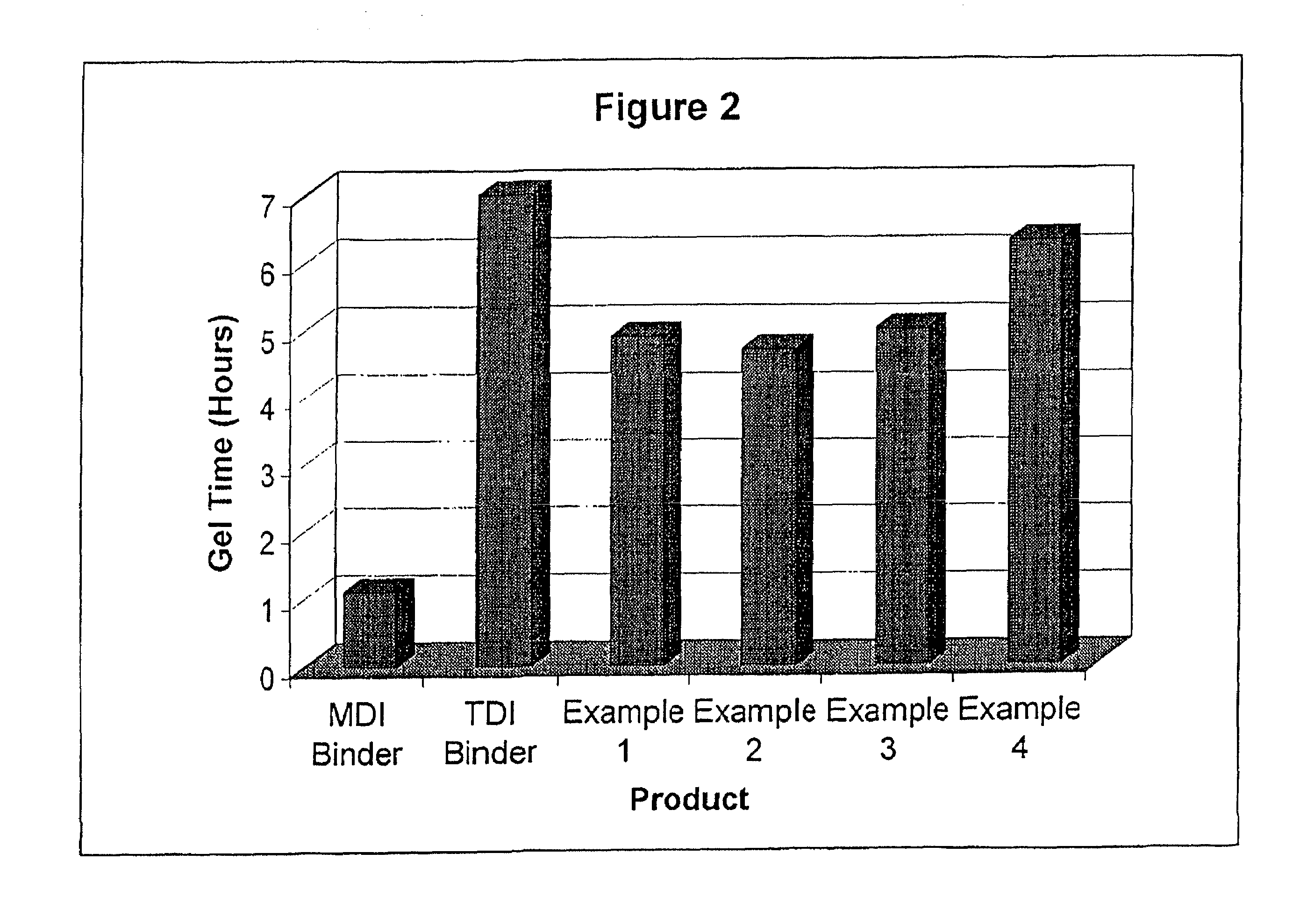Moisture-curing polyurethane material having a long gel time
a polyurethane material and gel time technology, applied in the field of one-component polyurethane adhesives and binding materials, can solve the problems of short gel time, short pot life of commonly used mdi-only binders, and objectionable individuals to polyurethane binders with volatile irritating components, etc., to achieve long pot life, avoid health risks associated, and good adhesion
- Summary
- Abstract
- Description
- Claims
- Application Information
AI Technical Summary
Benefits of technology
Problems solved by technology
Method used
Image
Examples
example 1
[0019]A resilient surface was prepared from a mixture of rubber crumb and binder. The binder was prepared by mixing 698 parts by weight, e.g., grams, of a polyether polyol (a diol having a molecular weight of 4,000 (PPG-4000 available from Bayer)), with 7 parts by weight of di(propylene glycol), and 295 parts by weight of MDI (a 50 / 50 mixture by weight of 4,4′-diphenylmethane diisocyanate and 2,4′-diphenylmethane diisocyanate). The binder components were stirred for two hours at 80° C. to give a polyurethane pre-polymer as a colorless oil. The resulting pre-polymer binder had an isocyano (NCO) content of 8.0% by weight, a viscosity of 2,700 cP at 27° C. and a gel time of 4.9 hours at 25° C., 20.5° C. dewpoint, and 77% humidity. The cured film of the binder had a tensile strength of 2,121 psi and an elongation of 622%.
[0020]A mixture was made of 200 g of the pre-polymer binder and 800 g of recycled rubber crumb having a grain size from 1 to 3 mm. The mixture was stirred until the rub...
example 2
[0021]An adhesive binder was prepared by stirring 7 parts by weight of di(propylene glycol) with 295 parts by weight of MDI (a 50 / 50 by weight mixture of 4,4′-diphenylmethane diisocyanate and 2,4′-diphenylmethane diisocyanate) for one hour at 35–55° C. A polyether polyol (a diol having a molecular weight of 4,000 (PPG-4000 available from Bayer)), 698 parts by weight, was then added and the mixture was stirred for two additional hours at 80° C. The resulting polyurethane binder was a colorless oil with a NCO content of 8.0% by weight, a viscosity of 2,800 cP at 26° C., and a gel time of 4.7 hours at 25° C., 22° C. dewpoint, and 84% humidity. The cured film of the polyurethane binder had a tensile strength of 2,080 psi and an elongation of 630%.
[0022]A mixture was made of 200 g of the polyurethane binder and 800 g of recycled rubber crumb having a grain size of 1 to 3 mm. The mixture was stirred until the rubber crumbs were completely wetted with binder and then about half of the mixt...
example 3
[0023]An adhesive binder was prepared by mixing 698 parts by weight of a polyether polyol (a diol with a molecular weight of 4,000 (PPG-4000 available from Bayer)), 295 parts by weight of MDI (a 50 / 50 mixture by weight of 4,4′-diphenylmethane diisocyanate and 2,4′-diphenylmethane diisocyanate). This mixture was stirred for two hours at 80° C. and cooled to 65° C. Seven parts by weight of di(propylene glycol) were then added and this mixture was stirred for one hour at about 40 to 65° C. The resulting polyurethane binder was obtained as a colorless oil and has a NCO content of 8.0% by weight, a viscosity of 3,200 cP at 25° C., and a gel time of 5 hours at 25° C., 18° C. dewpoint, and 64% humidity. A cured film of the binder had a tensile strength of 2,160 psi and an elongation of 590%.
[0024]A mixture was made of 200 g of the polyurethane binder and 800 g of recycled rubber crumb having a grain size of 1 to 3 mm and the mixture was stirred until the rubber crumbs were completely wette...
PUM
| Property | Measurement | Unit |
|---|---|---|
| Temperature | aaaaa | aaaaa |
| Fraction | aaaaa | aaaaa |
| Fraction | aaaaa | aaaaa |
Abstract
Description
Claims
Application Information
 Login to View More
Login to View More - R&D
- Intellectual Property
- Life Sciences
- Materials
- Tech Scout
- Unparalleled Data Quality
- Higher Quality Content
- 60% Fewer Hallucinations
Browse by: Latest US Patents, China's latest patents, Technical Efficacy Thesaurus, Application Domain, Technology Topic, Popular Technical Reports.
© 2025 PatSnap. All rights reserved.Legal|Privacy policy|Modern Slavery Act Transparency Statement|Sitemap|About US| Contact US: help@patsnap.com


